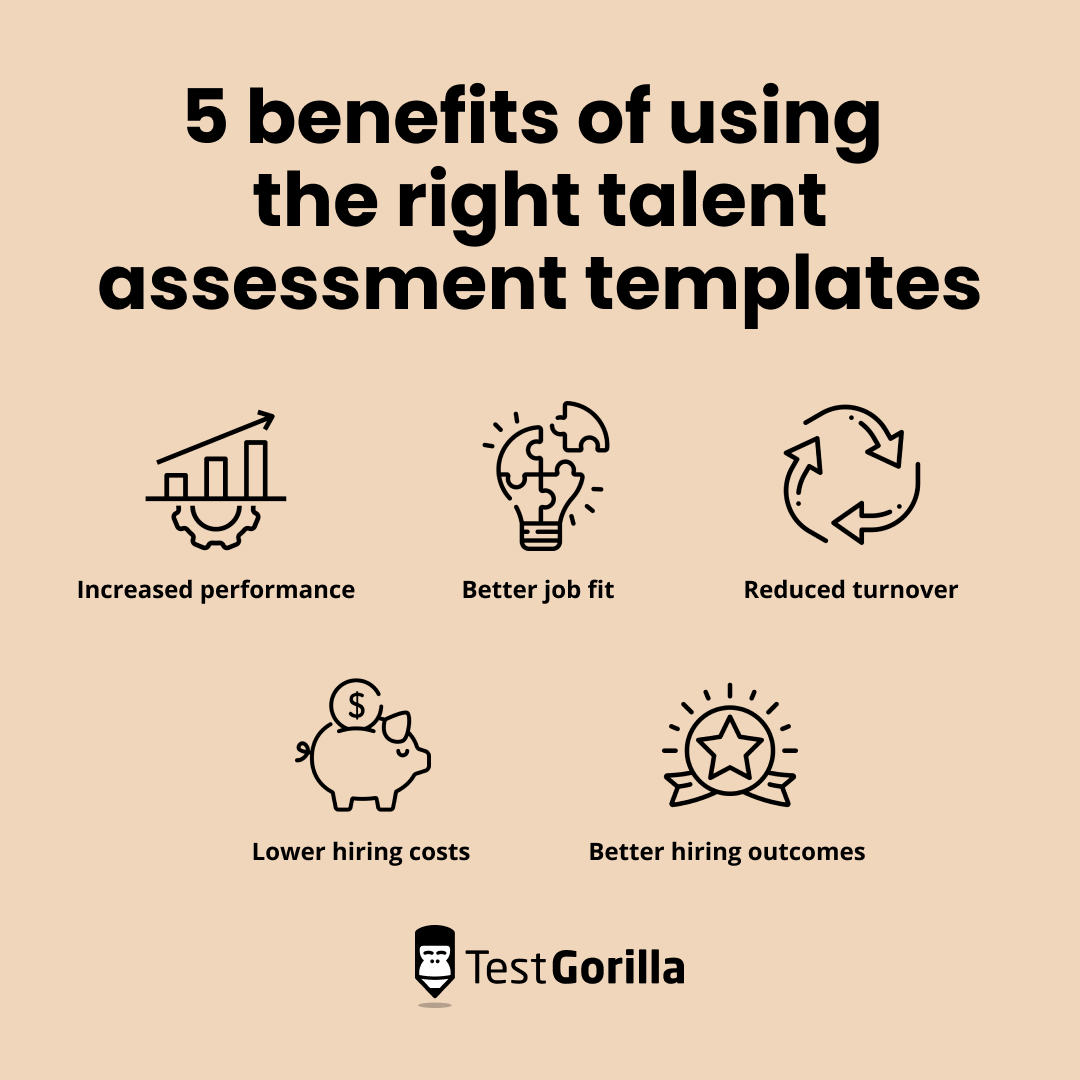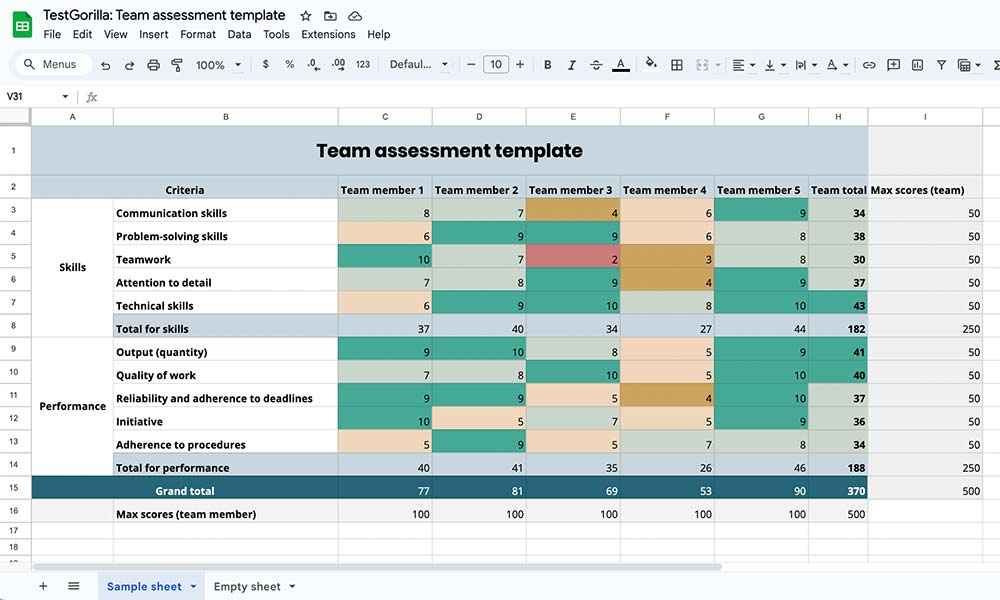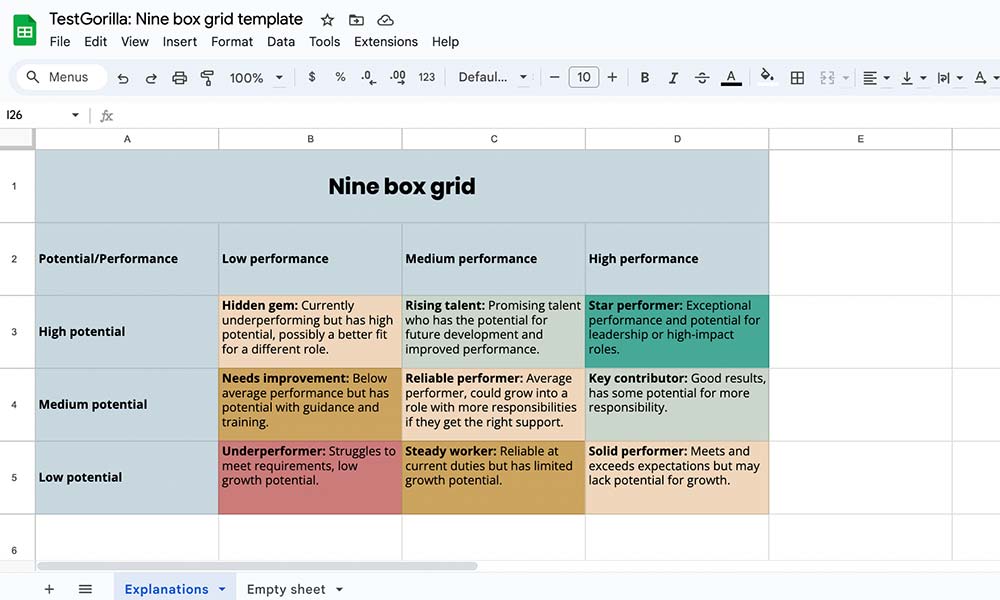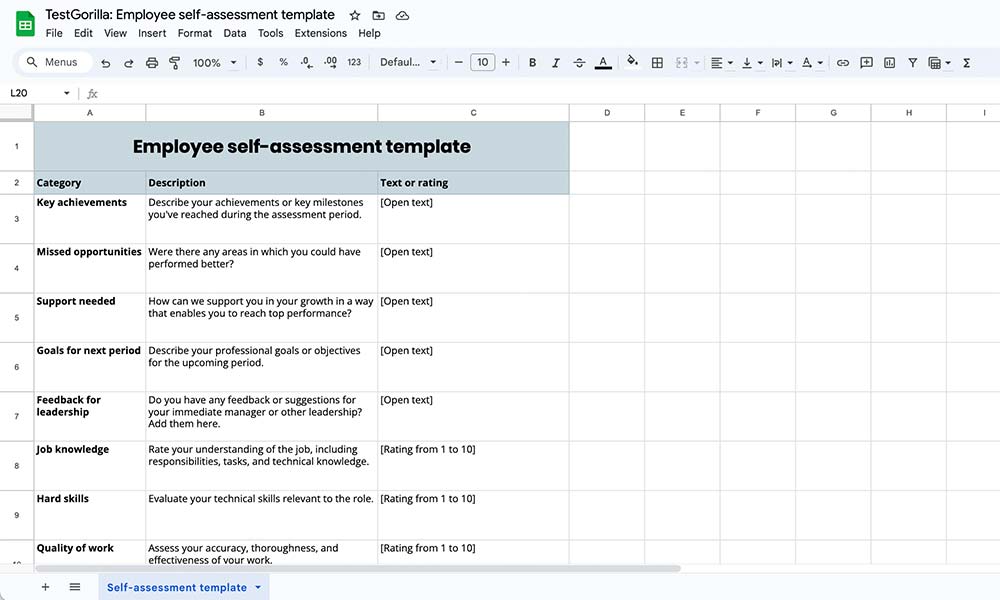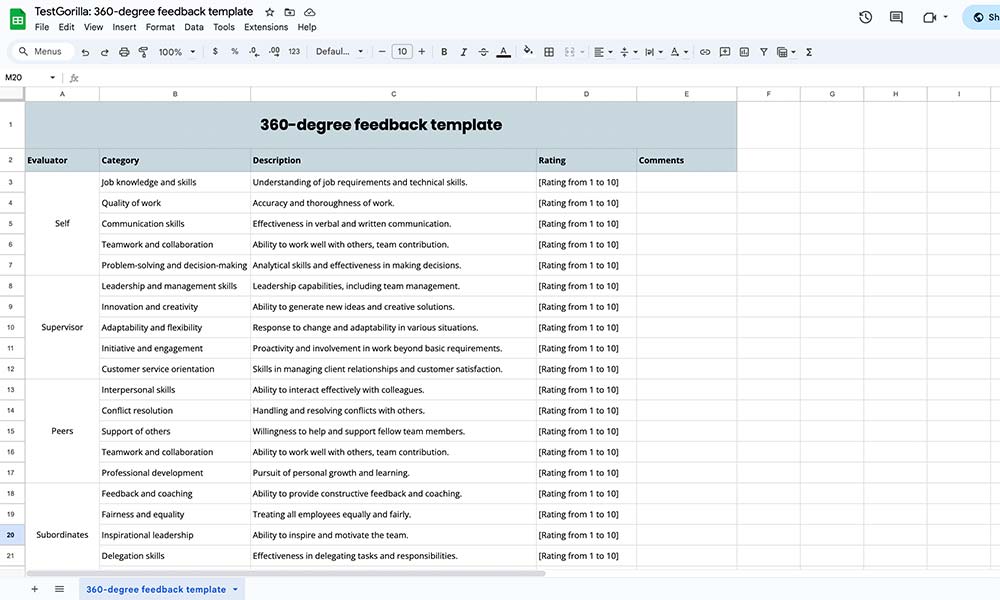Top 5 talent assessment templates to map your organization’s talent plus free Google Sheets
Talent assessment is crucial when you want to identify and retain highly skilled performers who can grow within your organization. To succeed, you need to start cultivating today the talent that your company will need tomorrow.
As Peter Drucker and others have rightfully pointed out, human resources are the most important asset of your company. Developing a strategic approach toward hiring, upskilling, and retaining talent is a key step in growing your business.
But talent assessment and talent mapping can be time-consuming processes. To streamline them and ensure you’re getting the best results, we’ve built five talent assessment templates you can start using today for free.
Below, you’ll find a Google Sheet for each one, along with details on how to make the most of them.
But first, let’s cover the basics – what talent assessment is and how you can benefit from it.
Table of contents
What is talent assessment?
Talent assessment refers to one of two things:
Screening your candidate pool when looking to fill an open position so you can pick the most suitable applicant
Evaluating your existing talent to identify talent gaps, improvement opportunities, and hiring needs
It’s usually handled by a business’ human resources (HR) department or sometimes by external recruiters or HR specialists.
The process of talent assessment is highly nuanced. Using the right software tools and templates enables you to handle it the right way, without overlooking important data or making biased decisions.
The right approach to talent assessment will enable you to build a robust talent strategy and hire and retain the right people.
The data confirms the need for conducting talent assessments: A 2022 survey by SHRM revealed that 78% of HR professionals have seen the quality of their hires improve when using talent assessments.
Conversely, talent assessment that lacks structure or relies on gut feelings or preferences rather than on data can lead to disastrous results. That is because the process of talent assessment affects every aspect of your business, including:
The use of resources: Recruiting, interviewing, and onboarding can be very resource-intensive and the cost of a bad hire is high
Staff turnover: When you fail to assess your candidates accurately, you end up hiring the wrong people – and they won’t stay for long (not to mention the negative impact of bad hires on the productivity of your entire team)
Employee satisfaction: Turnover affects all employees and may have a downstream impact on whether they perceive your company as stable
What are the benefits of using the right talent assessment templates?
Talent assessment provides data-based insights into your candidates’ and employees’ aptitudes, technical and soft skills, behaviors, and personality traits.
Using the right talent assessment templates will enable you to get a better grasp of the strengths and weaknesses of each candidate, employee, or team.
This, in turn, will help you hire better, optimize your team’s performance, identify learning and development opportunities to help employees grow, and build a diverse workforce of top talent who are aligned with your company’s goals.
Here are some of the benefits of using the right talent assessment tools and templates:
Increased performance
Better job fit
Reduced turnover
Lower hiring costs
Better hiring outcomes
The best insights on HR and recruitment, delivered to your inbox.
Biweekly updates. No spam. Unsubscribe any time.
Top 5 talent assessment templates (+ free Google Sheets)
Talent assessment can look like a daunting task, especially if you have no prior experience with it.
To help you streamline the process, we’ve built five talent assessment templates you can start using immediately, along with detailed information about each one.
You can copy and use the Google Sheets that TestGorilla’s team has designed for you, starting today.
Talent assessment template for a team
A team’s performance matters just as much as that of an individual employee’s. You can view teams as units that must have particular skills and aptitudes to complete assigned projects.
Here’s what our talent assessment template for teams looks like:
This team talent assessment template enables you to focus on every member of your team and their individual skills and performance. This, in turn, shows you how they work together as a unit. Looking at the whole picture will increase your ability to manage and support your team and help each person grow.
Here’s how to use the table:
Make a copy of the Google Sheet from File > Make a copy. This way, you’ll be able to edit the document. There are two sheets, an empty one and a sample one, which is pre-filled.
Define the skills and performance criteria you’d like to assess (column B of the “Empty sheet” tab). We’ve split the table in two parts, skills and performance, and listed five areas for each, but you can decide to assess only skills, only performance, focus on hard and soft skills, or use another approach. You can also evaluate more than five skills and performance criteria.
Define the team members you’d like to assess (row 1). We’ve built the table for a team of five, but you can add more team members or use it for fewer people. Remember to adjust the max scores by the number of team members if you add more employees (column I).
Assess the skills and performance of each team member, using scores from 1 to 10. To assess skills, you can use a selection of TestGorilla’s tests based on the team’s type and specific needs. Make sure to assess role-specific skills, proficiency with software tools that the team uses, and cognitive ability. You can also use personality tests to gain deeper insights into your team members’ behaviors and personality traits. To assess performance, look at results for the past quarter or six months.
Add the scores of each team member to the table. We’ve added conditional formatting to the score section of the table and color-coded each range, which gives you an instant visual representation of your team’s performance and skills.
Use the total scores for each skill and team member to determine areas of improvement. Once you fill out the entire table, you’ll be able to quickly see which areas require further work – and who needs more support. Use this data to inform your future learning and development initiatives.
The nine box grid
The nine box grid is one of the most popular talent assessment tools – or, as the Harvard Business Review refers to it, one of the secret ingredients of a successful talent-review system.
It was originally developed by McKinsey & Company, one of the best-known management consulting organizations in the world. They created the nine box grid in 1970 as a strategic tool that enables leaders to identify and prioritize key investments and compare business units.
Today, it’s one of the most widely used talent assessment templates to evaluate the most important asset of every business – its employees.
Here’s what the 9-box grid template looks like:
A nine box grid has two axes – the X-axis (performance) and the Y-axis (potential). Each has three levels: high, medium, and low.
This translates into a three-by-three matrix, where each of the nine boxes corresponds to a particular category. You can use these categories to evaluate your employees and place them where they fit best.
Here’s how to use the table:
Make a copy of the Google Sheet from File > Make a copy. This way, you’ll be able to edit the document. There are two sheets, “Explanations” and “Empty sheet”.
Assess each employee’s performance and potential. This will enable you to see where to place each team member (more on that below).
Fill out the table. Use the “Empty sheet” tab.
Analyze results. This talent assessment template enables you to see who your top performers are, who needs more support from you to grow, and who is pulling the team down.
To assess performance, you need to look at each employee’s:
Performance in the past three to six months
Participation in key projects and outcomes
Work with other team members
To evaluate potential, we advise you to use skills tests. TestGorilla offers a wide range of tests you can use to evaluate your employees’ skills and knowledge in many different domains. You can combine up to five skills in a single assessment and add custom questions for a more granular evaluation.
This way, you’ll quickly find out who has the potential to take on more responsibility or even a leadership role in the future – and who might benefit from changing the scope of their current position.
If you’ve already done a team talent assessment (from the previous section), you can use results to fill out the nine box grid.
Employee self-assessment template
According to career and leadership coach Caroline Castrillon, self-awareness is essential for career success. Using regular self-assessments encourages self-awareness and skill development.
Reflective practice and self-monitoring are vital skills for every employee. Administering self-assessments regularly will help you develop them in your workforce – and will help you begin the discussion on difficult topics, such as missed opportunities and how you can support your employees better.
Here’s what the employee self-assessment template looks like:
It features two parts:
In the first part (rows 3 to 7), your employee can describe their achievements, weaknesses, and the things that would help enhance their performance
In the second part (rows 8 to 17), your employee needs to rate their skills and performance based on different criteria, using a score from 1 to 10 for each
To use it, you need to:
Make a copy of the Google Sheet from File > Make a copy. This way, you’ll be able to edit the document.
Define how often you’d like to administer this self-assessment. For example, you could do it every quarter, every six months, or every year. Whatever frequency you choose, make sure you actually have the capacity to evaluate results and progress.
Administer it to each employee or team member. Reassure employees that the goal of this self-assessment is simply to help them grow and support them in their professional advancement, rather than to penalize them for any self-assessed weaknesses (and make sure to follow through with that).
Analyze results and discuss them with employees. Make the time to discuss results with each employee in a one-on-one meeting.
360-degree talent assessment template
The 360-degree feedback assessment is a method that uses constructive feedback from multiple sources to help you understand a person’s talents and flaws.
Receiving confidential evaluations from managers, peers, and the people a person reports to can give much food for thought and promote growth in the workplace.
The 360-degree feedback assessment is administered through a questionnaire that covers a range of work-related matters and competencies.
Different team members, superiors, subordinates, and, in some cases, clients fill out the form anonymously and one person (such as the HR manager) calculates average scores.
In parallel to that, the person who is evaluated fills out a self-rating form and receives the feedback.
Here’s what the 360-degree talent assessment Google Sheet template looks like:
For this, you need to:
Make a copy of the Google Sheet from File > Make a copy. This way, you’ll be able to edit the document.
Define the frequency with which you’ll administer the 360-degree evaluation. Given that this type of talent assessment is quite resource-intensive, you can opt to do it as a part of employees’ annual evaluations.
Ask the person you’re evaluating to self-assess their performance and skills. If you use a self-assessment template (from the previous section), you can use data from it.
Prepare a questionnaire for peers, supervisors, subordinates, and, optionally, clients, and ask them to fill it out. Define five criteria for each type of relationship (in our table, you can find TestGorilla’s suggestions) and ask each person to rate the employee based on these five criteria.
Analyze and discuss results with the employee. Once you collect all evaluations, discuss results with the employee.
Motivation and culture-add assessment
Motivation and cultural alignment are critical for every organization. Hiring highly motivated employees will result in:
An overall increase of efficiency and employee satisfaction
Higher productivity
Strong work relationships
Stability in the workforce
Based on Oldman & Hackman’s Job Characteristic model, TestGorilla’s online Motivation test will help you measure the extent to which your candidate’s or employee’s expectations align with your job offer and how motivated they are.
Culture add assessments have a similar value for the hiring process – or even for team management.
Hard and soft skills can be developed over time but compatibility is something that is either there or isn’t. Assessing whether your candidates’ and employees’ values and behaviors are aligned with your company culture is fundamental for making a good hire.
The Culture Add test will help you identify people who are aligned with your company’s mission and will support and promote your organizational culture.
Here’s what the motivation and culture-add assessment template looks like:
To use the template:
Make a copy of the Google Sheet from File > Make a copy
Administer TestGorilla’s Motivation and Culture Add tests
Add results to the table (in percentage form; the cells are pre-formatted accordingly) and check average scores
We advise you to use those two tests in combination with other tests of candidates’ or employees’ specific skills and abilities.
Why use talent assessment tools and templates in HR management and hiring
Using the right talent assessment tools is the key to making the right hiring and talent management decisions – no matter what exactly each job entails or how skilled a particular person seems to be.
TestGorilla is an interactive psychometric test platform that provides standardized talent assessments that can help you make informed decisions about each candidate and employee.
If you combine our talent assessments with the templates you can find above, you can build simple, straightforward, and objective hiring and talent management processes.
The skills assessments we offer are scientifically validated and cover a wide range of skills, including language, programming, and cognitive abilities. The entire process is automated so you can give all applicants an equal opportunity to demonstrate their skills.
Basing your hiring and talent management processes on objective data will enable you to:
Identify the best person for each role
Support your employees in a way that is meaningful to them and that helps unlock their true performance potential
Eliminate unconscious bias
Provide a better candidate and employee experience
Use talent assessment templates to make better decisions, faster
Effective talent assessment is critical for the success of your business. Using talent assessment templates like the ones in this article makes the process easier and faster – especially if you combine them with a robust talent assessment platform like TestGorilla.
Grab your copies of each talent assessment template we’ve built for you in Google Sheets:
Above, you’ll find the explanations and instructions on how to use each template. Our platform is very versatile, so you can use TestGorilla to evaluate your workforce and candidates.
Try out TestGorilla for free today – or sign up for a 30-minute live demo to see for yourself how easy it is to evaluate your talent with it.
You've scrolled this far
Why not try TestGorilla for free, and see what happens when you put skills first.



